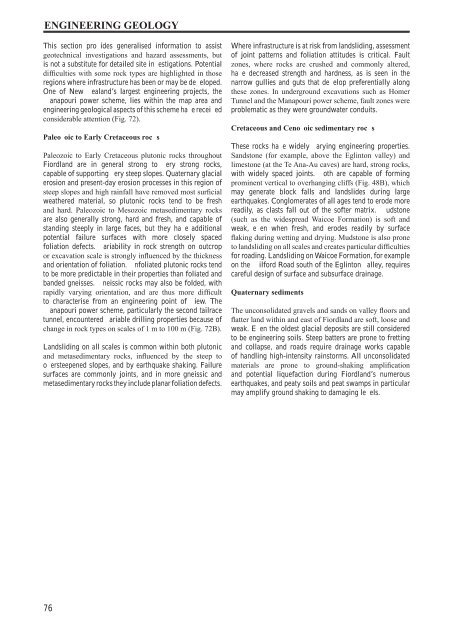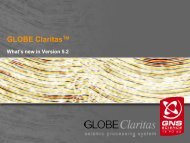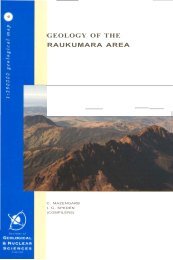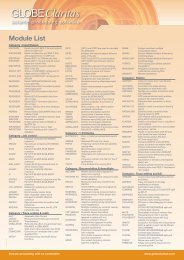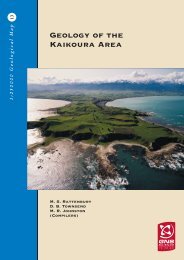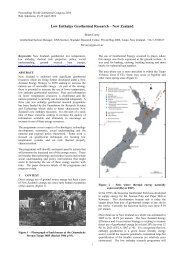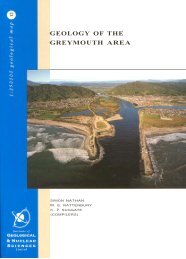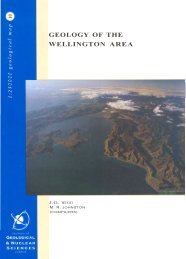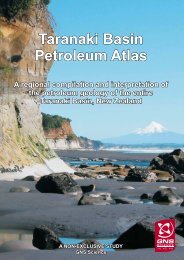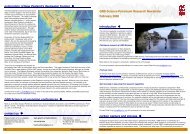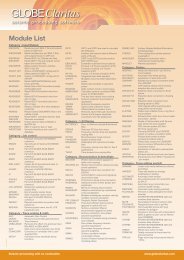Geology of the Fiordland Area - GNS Science
Geology of the Fiordland Area - GNS Science
Geology of the Fiordland Area - GNS Science
- No tags were found...
Create successful ePaper yourself
Turn your PDF publications into a flip-book with our unique Google optimized e-Paper software.
ENGINEERING GEOLOGYThis section pro ides generalised information to assistgeotechnical investigations and hazard assessments, butis not a substitute for detailed site in estigations. Potentialdifficulties with some rock types are highlighted in thoseregions where infrastructure has been or may be de eloped.One <strong>of</strong> New ealand’s largest engineering projects, <strong>the</strong>anapouri power scheme, lies within <strong>the</strong> map area andengineering geological aspects <strong>of</strong> this scheme ha e recei edconsiderable attention (Fig. 72).Paleo oic to Early Cretaceous roc sPaleozoic to Early Cretaceous plutonic rocks throughout<strong>Fiordland</strong> are in general strong to ery strong rocks,capable <strong>of</strong> supporting ery steep slopes. Quaternary glacialerosion and present-day erosion processes in this region <strong>of</strong>steep slopes and high rainfall have removed most surficialwea<strong>the</strong>red material, so plutonic rocks tend to be freshand hard. Paleozoic to Mesozoic metasedimentary rocksare also generally strong, hard and fresh, and capable <strong>of</strong>standing steeply in large faces, but <strong>the</strong>y ha e additionalpotential failure surfaces with more closely spacedfoliation defects. ariability in rock strength on outcropor excavation scale is strongly influenced by <strong>the</strong> thicknessand orientation <strong>of</strong> foliation. nfoliated plutonic rocks tendto be more predictable in <strong>the</strong>ir properties than foliated andbanded gneisses. neissic rocks may also be folded, withrapidly varying orientation, and are thus more difficultto characterise from an engineering point <strong>of</strong> iew. Theanapouri power scheme, particularly <strong>the</strong> second tailracetunnel, encountered ariable drilling properties because <strong>of</strong>change in rock types on scales <strong>of</strong> 1 m to 100 m (Fig. 72B).Landsliding on all scales is common within both plutonicand metasedimentary rocks, influenced by <strong>the</strong> steep too ersteepened slopes, and by earthquake shaking. Failuresurfaces are commonly joints, and in more gneissic andmetasedimentary rocks <strong>the</strong>y include planar foliation defects.Where infrastructure is at risk from landsliding, assessment<strong>of</strong> joint patterns and foliation attitudes is critical. Faultzones, where rocks are crushed and commonly altered,ha e decreased strength and hardness, as is seen in <strong>the</strong>narrow gullies and guts that de elop preferentially along<strong>the</strong>se zones. In underground excavations such as HomerTunnel and <strong>the</strong> Manapouri power scheme, fault zones wereproblematic as <strong>the</strong>y were groundwater conduits.Cretaceous and Ceno oic sedimentary roc sThese rocks ha e widely arying engineering properties.Sandstone (for example, above <strong>the</strong> Eglinton valley) andlimestone (at <strong>the</strong> Te Ana-Au caves) are hard, strong rocks,with widely spaced joints. oth are capable <strong>of</strong> formingprominent vertical to overhanging cliffs (Fig. 48B), whichmay generate block falls and landslides during largeearthquakes. Conglomerates <strong>of</strong> all ages tend to erode morereadily, as clasts fall out <strong>of</strong> <strong>the</strong> s<strong>of</strong>ter matrix. udstone(such as <strong>the</strong> widespread Waicoe Formation) is s<strong>of</strong>t andweak, e en when fresh, and erodes readily by surfaceflaking during wetting and drying. Mudstone is also proneto landsliding on all scales and creates particular difficultiesfor roading. Landsliding on Waicoe Formation, for exampleon <strong>the</strong> ilford Road south <strong>of</strong> <strong>the</strong> Eglinton alley, requirescareful design <strong>of</strong> surface and subsurface drainage.Quaternary sedimentsThe unconsolidated gravels and sands on valley floors andflatter land within and east <strong>of</strong> <strong>Fiordland</strong> are s<strong>of</strong>t, loose andweak. E en <strong>the</strong> oldest glacial deposits are still consideredto be engineering soils. Steep batters are prone to frettingand collapse, and roads require drainage works capable<strong>of</strong> handling high-intensity rainstorms. All unconsolidatedmaterials are prone to ground-shaking amplificationand potential liquefaction during <strong>Fiordland</strong>’s numerousearthquakes, and peaty soils and peat swamps in particularmay amplify ground shaking to damaging le els.76


